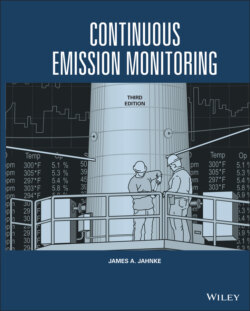Читать книгу Continuous Emission Monitoring - James A. Jahnke - Страница 66
Compliance Indicating Systems – Using CEM Systems for Reporting Excess Emissions
ОглавлениеFederal CEM requirements were originally developed in 1975 to provide a means for sources and agencies to check the operation and performance of NSPS‐mandated control equipment such as bag houses and wet scrubbers. The intention was that the source could use the emissions data to track the control system performance, and that reports would be submitted quarterly to the agency. These reports, called excess emission reports (EERs), were to include data on the exceedances of emissions standards.
In 1975, new fossil‐fuel‐fired steam generators (FFFSGs), petroleum refineries, nitric acid plants, and sulfuric acid plants were the first source categories in the United States required to report such data on a quarterly basis. The excess emission reports can be used for the following:
1 To indicate if the source is using good operating and maintenance practices on its process and its control equipment to minimize emissions
2 To provide the agency with data on upset conditions or trend data indicating degradation of control equipment performance
3 To provide the agency with a continuous record of the source's ability to comply with standards
4 To provide a screening tool in inspection targeting programs
5 To provide the agency with sufficient data to issue a Notice of Violation (NOV) if the source is not complying with regulations or standards
Under U.S. regulations when CEM data are used for excess emissions reporting, the data usually have not been used alone as legally enforceable determinants of emission exceedances. Instead, the data have been used to show that a problem exists and, based upon the severity of the problem, the agency takes further action, which might include conducting reference method tests for determining compliance with emissions standards. The reference method test data would then determine if the source was complying with its emissions standards.
Using EER data to show that a system is not meeting emissions standards and then requiring an EPA compliance test to initiate legal action is cumbersome to some. The advantage, however, is that this method offers the agency significant negotiating power and provides flexibility in the enforcement program. The problem is that evaluating excess emission reports and following up with inspections and compliance tests can require more time and resources than an agency may have available.
Until 1997, many states adopted the position that excess emission report (EER) data would not be used to refer cases to the Department of Justice or to issue an order of noncompliance, unless other regulatory mandates specify the CEM system as the compliance method (as a compliance indicating systems). Actually, this position has not precluded the use of EER data in enforcement cases. Because an agency may review all available information when evaluating the compliance status of a source, the CEM data can constitute part of the record of an enforcement proceeding. Section 113 of the Clean Air Act states:
“Whenever, on the basis of any information available to him, the Administrator finds that any person is in violation of any standard of performance…he may bring a civil action in accordance with subsection 113(a).”
EPA can use EER data alone, as a basis for issuing a “finding of violation” (FOV) or a “notice of violation” (NOV) (U.S. EPA – OAQPS, 1984, Reich). If the source does not come into compliance after an FOV or NOV is issued, EPA must acquire compliance test (Reference Method) data before it can initiate litigation or issue a Notice of Noncompliance (NON). However, NOVs have been issued using CEM data on the basis of the Clean Air Act Section 113(a) to effectively enforce source compliance (McCoy 1985, 1990).
For agency personnel, a handbook providing procedures for reviewing excess emission reports is available (Quarles and Peeler 1986). A more recent review guideline, developed by the Commonwealth of Virginia Department of Air Quality (VADEQ), extends review procedures to predictive emission monitoring systems (PEMS) and continuous parametric monitoring systems (CPMS) as well as CEM systems (VADEQ 2018).
